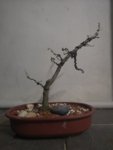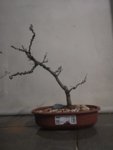Hi Leo,
Thanks! That is the greatest complete guide I got!! I just updated my profile. I live in Malaysia, just next to Philippines. Due to tropical climate we got here I am sure I have more time to work on this tree.
This tree is not dormant but I defoliated 90% leaving only very small leaves. I did this after repotting from deep into shallow pot to make nebari, giving the roots chances to utilize energy to adapt into new substrate and pot. The leaves grows more and healthy right now.
I thought earlier about the trunk chop just as you suggested, but I worried about wasting the branch. Now I got some guts to do trunk chop. I will let it recover from repotting then I will chop the trunk at the redline. Clip hard and grow can produce good taper, isn't it?
Thanks
I visited Malaysia once, back in 1994. Spent 2 days in Malacca, one night at the casino in the Genting Highlands, 2 days in KL, and an all too short 18 hours on Palau Pangkor. I was touring as one of 7 english only speakers in a group of 40 Chinese Nationals, which meant I saw the parts of Malaysia that the Chinese nationals wanted to see, rather than the typical tourist sites that a USA based tour group would have sent me to. From the time I landed in Singapore until I left from KL, I ate local food. No ''American'' food the entire trip. It was really fun. Ba Ku Te in the KL night market is a fond food memory. Palau Pangkor was like stepping into a ''fantasy island'', beautiful beyond words. In the Genting Highlands, while the rest of the group was gambling in the casino, I took a hike into the rain forest above the hotel. Made the mistake of not planning carefully to return to the hotel before nightfall. Within minutes of a beautiful sunset, a dense fog rolled in so thick I could not see my feet. We felt our way back, with our feet, if you felt gravel, you were on the trail, soft leaf litter, you were not on the trail. It was exciting, and turned out well, with no incidents or injuries.
So I am always happy when someone from Malaysia joins BNut.
Given your climate, you should be able to keep this tree growing year round without dormancy. This means development will be very rapid compared to what we see in North America. That is great.
Grow out, then cut back, in repeated cycles can work very well. Let the tree get bushy, with many branches. Keep branches that appear lower than where you would like your first branch. These will be ''sacrifice branches'', to be allowed to grow and thicken the lowest part of the trunk, and be removed ''sacrificed'' or removed, when the trunk is the desired thickness. If the upper parts of the trunk will thicken too rapidly, this is why we let it grow out, then chop back. Otherwise the trunk will be a linear cylinder without any taper. The chops will also give you changes in direction. This will add movement to the trunk.
I forgot what size tree you want to have. For a one meter tall tree you might want a trunk of 20 cm diameter. You could have a trunk as slender as 7 cm, to as large as 40 cm, but a nice size for a meter tall tree would be 10 to 20 cm diameter. The ratio, height to diameter of trunk gives the illusion of age. 20:1 to 10:1 would give the impression of a slender young tree. or a forest tree, or a tall lone mountain tree, literati. Ratio of 5:1 to 4:1 are common for mature look, like a tree growing in an open field. Ratios of 3:1, 2:1 and 1:1 are exaggerated styles, reserved for gnarled, contorted ancient trees, or the exaggerated ''Sumo'' style, which is extreme beyond anything in nature.
With your tree I would go for 10:1 to something near 5:1. and you could get there in just a few years.
Each segment of trunk is increased in diameter by the amount of foliage, leaf surface area, that each segment supports plus the foliage above. But the foliage above also thickens the trunk segments above. So this is why you build the trunk in segments, because otherwise the upper parts of the trunk will be too large in diameter, and detract from the illusion of age.










